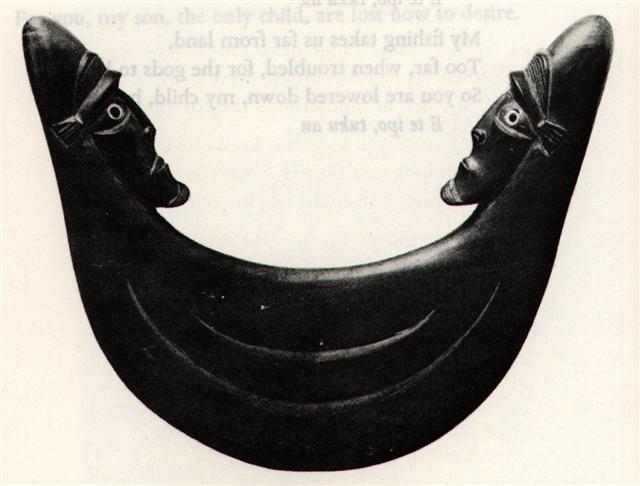|
TRANSLATIONS
This is the 2nd period of daylight. Now the sun has been released (born) from Mother Earth. He will soon and quickly grow up, illustrated by the hand feeding him. And in Aa1-19 tapa mea is turned the right way. Yes, Sun (Son) now certainly is on his way. The arm in Aa1-18 is incised in the wood of the rongorongo tablet with the purpose of showing us the boat of the sun. Like Moses the sun arrives by boat after his birth. On the underside of this canoe of the sun there are two appendages. They are symbols and not what you can see for real. The same kind of appendages are normally written in the rongorongo glyph for rei miro, but they are not found in the real concrete rei miro (miro means both wood, wooden and ship, and rei miro is a wooden pectoral to be worn by kings):
In the rei miro glyph type (names such as rei miro are just labels invented by me to make it easier to talk about the different glyph types) the appendages mark the 'back side' (tu'a) of the glyph, and also (just as in Aa1-18) the underside of the canoe. Both back and under refer to the dark side of something. The canoe (which also rei miro symbolizes) has its underside in the water and water means darkness, light quickly diminishes as we dive deeper. These two appendages are similar to the sign Y. Another way to regard them is to identify them with waxing and waning moon. Moon means night (darkness) and the moon is close to earth, not as far away as the sun. A baby is delivered together with water, both from mother. In Aa1-19 the direction is now as it should, forward. The six marks forward symbolize the coming six double-hours of the true day, i.e. the central part of the day:
Three of the six marks are slanted one way, the other three the opposite way, just as the rays of the sun are directed one way before noon and in the opposite direction after noon. Direction is important in the rongorongo texts. Every other line of glyphs is written upside down. We start to read from the bottom line and there we first read from left to right, then - at the end of the line - we advance upwards one step and the text should now be read in the opposite direction. Though if we turn the board 180 degrees around (which is necessary for the inexperienced reader), we can continue to read from left to right. And the glyphs we are about to read will now - reassuringly - be standing on their feet again. If we don't turn the board around a glyph like tapa mea could give the impression of having its marks on the wrong (left) side. Considering this, it will now be clear why tapa mea has marks only on one side. The opposite side corresponds to night time. When we have daylight, people who live on the other side of the earth have night. Sun cannot shine on more than half the world at the same time. People on the other side of the earth are also standing upside down as regarded from us. For them what is right for us is wrong - a sentence which may be read in two different ways. They seem to be living in a mirror world. We may - in Tahua - read the oval of the tapa mea glyph as illustrating the orbit of the sun around the earth. They knew that the earth was round; certainly as they were the greatest navigators of the world. The orbit is not like a circle but oval. Near the equator the sun appears very quickly at the eastern horizon and later disappears equally fast in the west. In between these remarkable events it looks as if the sun is not in such a hurry. Therefore an oval shape is a truer description than a circle. |
||||||||||||||||||||||


